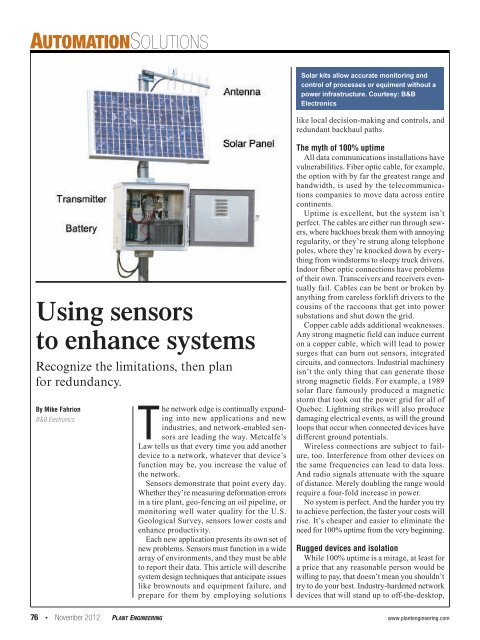2012 - PageSuite
2012 - PageSuite
2012 - PageSuite
You also want an ePaper? Increase the reach of your titles
YUMPU automatically turns print PDFs into web optimized ePapers that Google loves.
aUTOMaTIONSOLUTIONS<br />
Solar kits allow accurate monitoring and<br />
control of processes or equiment without a<br />
power infrastructure. Courtesy: B&B<br />
Electronics<br />
like local decision-making and controls, and<br />
redundant backhaul paths.<br />
Using sensors<br />
to enhance systems<br />
Recognize the limitations, then plan<br />
for redundancy.<br />
By Mike Fahrion<br />
B&B Electronics<br />
The network edge is continually expanding<br />
into new applications and new<br />
industries, and network-enabled sensors<br />
are leading the way. Metcalfe’s<br />
Law tells us that every time you add another<br />
device to a network, whatever that device’s<br />
function may be, you increase the value of<br />
the network.<br />
Sensors demonstrate that point every day.<br />
Whether they’re measuring deformation errors<br />
in a tire plant, geo-fencing an oil pipeline, or<br />
monitoring well water quality for the U.S.<br />
Geological Survey, sensors lower costs and<br />
enhance productivity.<br />
Each new application presents its own set of<br />
new problems. Sensors must function in a wide<br />
array of environments, and they must be able<br />
to report their data. This article will describe<br />
system design techniques that anticipate issues<br />
like brownouts and equipment failure, and<br />
prepare for them by employing solutions<br />
The myth of 100% uptime<br />
All data communications installations have<br />
vulnerabilities. Fiber optic cable, for example,<br />
the option with by far the greatest range and<br />
bandwidth, is used by the telecommunications<br />
companies to move data across entire<br />
continents.<br />
Uptime is excellent, but the system isn’t<br />
perfect. The cables are either run through sewers,<br />
where backhoes break them with annoying<br />
regularity, or they’re strung along telephone<br />
poles, where they’re knocked down by everything<br />
from windstorms to sleepy truck drivers.<br />
Indoor fiber optic connections have problems<br />
of their own. Transceivers and receivers eventually<br />
fail. Cables can be bent or broken by<br />
anything from careless forklift drivers to the<br />
cousins of the raccoons that get into power<br />
substations and shut down the grid.<br />
Copper cable adds additional weaknesses.<br />
Any strong magnetic field can induce current<br />
on a copper cable, which will lead to power<br />
surges that can burn out sensors, integrated<br />
circuits, and connectors. Industrial machinery<br />
isn’t the only thing that can generate those<br />
strong magnetic fields. For example, a 1989<br />
solar flare famously produced a magnetic<br />
storm that took out the power grid for all of<br />
Quebec. Lightning strikes will also produce<br />
damaging electrical events, as will the ground<br />
loops that occur when connected devices have<br />
different ground potentials.<br />
Wireless connections are subject to failure,<br />
too. Interference from other devices on<br />
the same frequencies can lead to data loss.<br />
And radio signals attenuate with the square<br />
of distance. Merely doubling the range would<br />
require a four-fold increase in power.<br />
No system is perfect. And the harder you try<br />
to achieve perfection, the faster your costs will<br />
rise. It’s cheaper and easier to eliminate the<br />
need for 100% uptime from the very beginning.<br />
Rugged devices and isolation<br />
While 100% uptime is a mirage, at least for<br />
a price that any reasonable person would be<br />
willing to pay, that doesn’t mean you shouldn’t<br />
try to do your best. Industry-hardened network<br />
devices that will stand up to off-the-desktop,<br />
76 • November <strong>2012</strong> plant engineering www.plantengineering.com

















